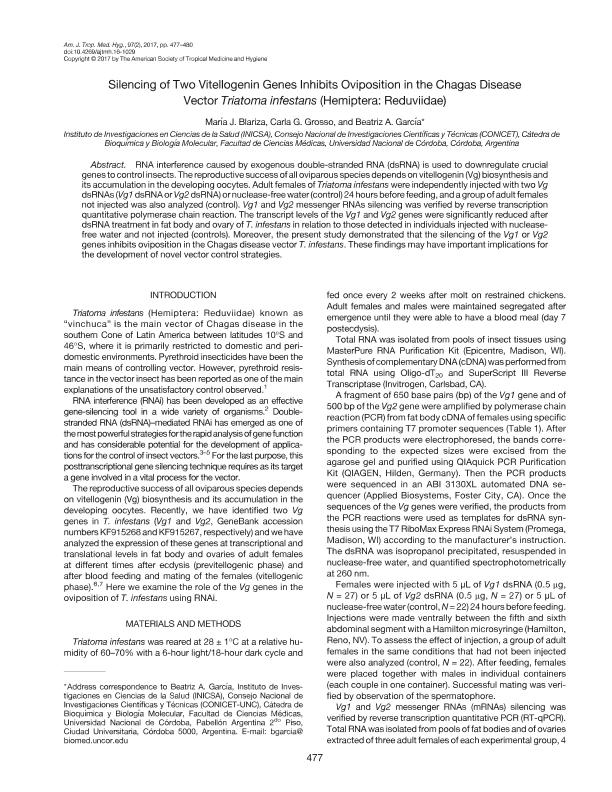Artículo
Silencing of two vitellogenin genes inhibits oviposition in the chagas disease vector triatoma infestans (Hemiptera: Reduviidae)
Fecha de publicación:
30/05/2017
Editorial:
American Society of Tropical Medicine and Hygiene
Revista:
American Journal of Tropical Medicine and Hygiene
ISSN:
0002-9637
Idioma:
Inglés
Tipo de recurso:
Artículo publicado
Clasificación temática:
Resumen
RNA interference caused by exogenous double-stranded RNA (dsRNA) is used to downregulate crucial genes to control insects. The reproductive success of all oviparous species depends on vitellogenin (Vg) biosynthesis and its accumulation in the developing oocytes. Adult females of Triatoma infestans were independently injected with two Vg dsRNAs (Vg1 dsRNA or Vg2 dsRNA) or nuclease-free water (control) 24 hours before feeding, and a group of adult females not injected was also analyzed (control). Vg1 and Vg2 messenger RNAs silencing was verified by reverse transcription quantitative polymerase chain reaction. The transcript levels of the Vg1 and Vg2 genes were significantly reduced after dsRNA treatment in fat body and ovary of T. infestans in relation to those detected in individuals injected with nucleasefree water and not injected (controls). Moreover, the present study demonstrated that the silencing of the Vg1 or Vg2 genes inhibits oviposition in the Chagas disease vector T. infestans. These findings may have important implications for the development of novel vector control strategies.
Palabras clave:
Triatoma Infestans
,
Chagas Disease Vector
,
Rna Interference
Archivos asociados
Licencia
Identificadores
Colecciones
Articulos(INICSA)
Articulos de INSTITUTO DE INVESTIGACIONES EN CIENCIAS DE LA SALUD
Articulos de INSTITUTO DE INVESTIGACIONES EN CIENCIAS DE LA SALUD
Citación
Blariza, María José; Grosso, Carla Gisela; Garcia, Beatriz Alicia; Silencing of two vitellogenin genes inhibits oviposition in the chagas disease vector triatoma infestans (Hemiptera: Reduviidae); American Society of Tropical Medicine and Hygiene; American Journal of Tropical Medicine and Hygiene; 97; 2; 30-5-2017; 477-480
Compartir
Altmétricas




